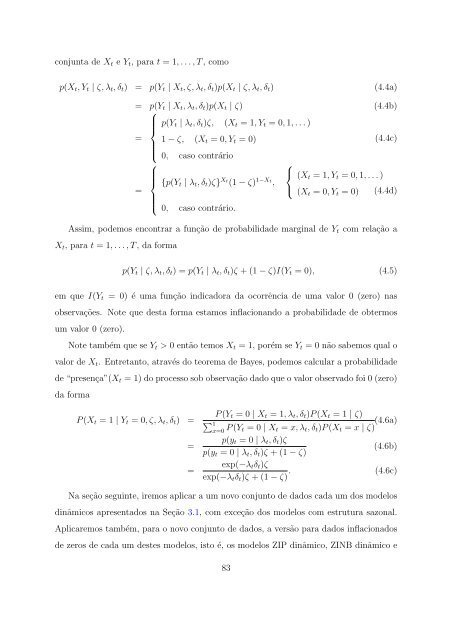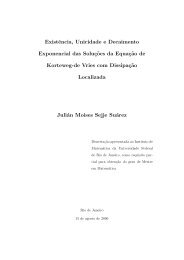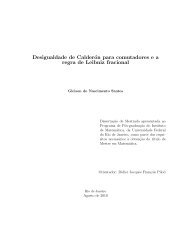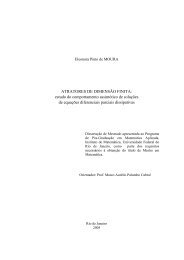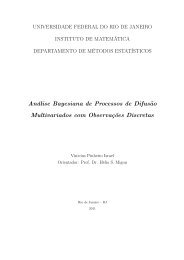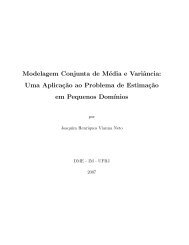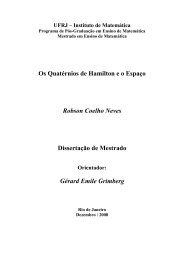Modelos para Dados de Contagem com Estrutura Temporal
Modelos para Dados de Contagem com Estrutura Temporal
Modelos para Dados de Contagem com Estrutura Temporal
You also want an ePaper? Increase the reach of your titles
YUMPU automatically turns print PDFs into web optimized ePapers that Google loves.
conjunta <strong>de</strong> X t e Y t , <strong>para</strong> t = 1, . . . , T , <strong>com</strong>o<br />
p(X t , Y t | ζ, λ t , δ t ) = p(Y t | X t , ζ, λ t , δ t )p(X t | ζ, λ t , δ t ) (4.4a)<br />
= p(Y t | X t , λ t , δ t )p(X t | ζ) (4.4b)<br />
⎧<br />
p(Y ⎪⎨ t | λ t , δ t )ζ, (X t = 1, Y t = 0, 1, . . . )<br />
= 1 − ζ, (X t = 0, Y t = 0)<br />
(4.4c)<br />
⎪⎩ 0, caso contrário<br />
⎧<br />
⎧<br />
⎨ (X ⎪⎨<br />
t = 1, Y t = 0, 1, . . . )<br />
{p(Y t | λ t , δ t )ζ} Xt (1 − ζ) 1−Xt ,<br />
=<br />
⎩ (X t = 0, Y t = 0) (4.4d)<br />
⎪⎩ 0, caso contrário.<br />
Assim, po<strong>de</strong>mos encontrar a função <strong>de</strong> probabilida<strong>de</strong> marginal <strong>de</strong> Y t <strong>com</strong> relação a<br />
X t , <strong>para</strong> t = 1, . . . , T , da forma<br />
em que I(Y t<br />
p(Y t | ζ, λ t , δ t ) = p(Y t | λ t , δ t )ζ + (1 − ζ)I(Y t = 0), (4.5)<br />
= 0) é uma função indicadora da ocorrência <strong>de</strong> uma valor 0 (zero) nas<br />
observações. Note que <strong>de</strong>sta forma estamos inflacionando a probabilida<strong>de</strong> <strong>de</strong> obtermos<br />
um valor 0 (zero).<br />
Note também que se Y t > 0 então temos X t = 1, porém se Y t = 0 não sabemos qual o<br />
valor <strong>de</strong> X t . Entretanto, através do teorema <strong>de</strong> Bayes, po<strong>de</strong>mos calcular a probabilida<strong>de</strong><br />
<strong>de</strong> “presença”(X t = 1) do processo sob observação dado que o valor observado foi 0 (zero)<br />
da forma<br />
P (X t = 1 | Y t = 0, ζ, λ t , δ t ) =<br />
P (Y t = 0 | X t = 1, λ t , δ t )P (X t = 1 | ζ)<br />
∑ 1<br />
x=0 P (Y t = 0 | X t = x, λ t , δ t )P (X t = x | ζ) (4.6a)<br />
=<br />
=<br />
p(y t = 0 | λ t , δ t )ζ<br />
p(y t = 0 | λ t , δ t )ζ + (1 − ζ)<br />
exp(−λ t δ t )ζ<br />
exp(−λ t δ t )ζ + (1 − ζ) .<br />
(4.6b)<br />
(4.6c)<br />
Na seção seguinte, iremos aplicar a um novo conjunto <strong>de</strong> dados cada um dos mo<strong>de</strong>los<br />
dinâmicos apresentados na Seção 3.1, <strong>com</strong> exceção dos mo<strong>de</strong>los <strong>com</strong> estrutura sazonal.<br />
Aplicaremos também, <strong>para</strong> o novo conjunto <strong>de</strong> dados, a versão <strong>para</strong> dados inflacionados<br />
<strong>de</strong> zeros <strong>de</strong> cada um <strong>de</strong>stes mo<strong>de</strong>los, isto é, os mo<strong>de</strong>los ZIP dinâmico, ZINB dinâmico e<br />
83


